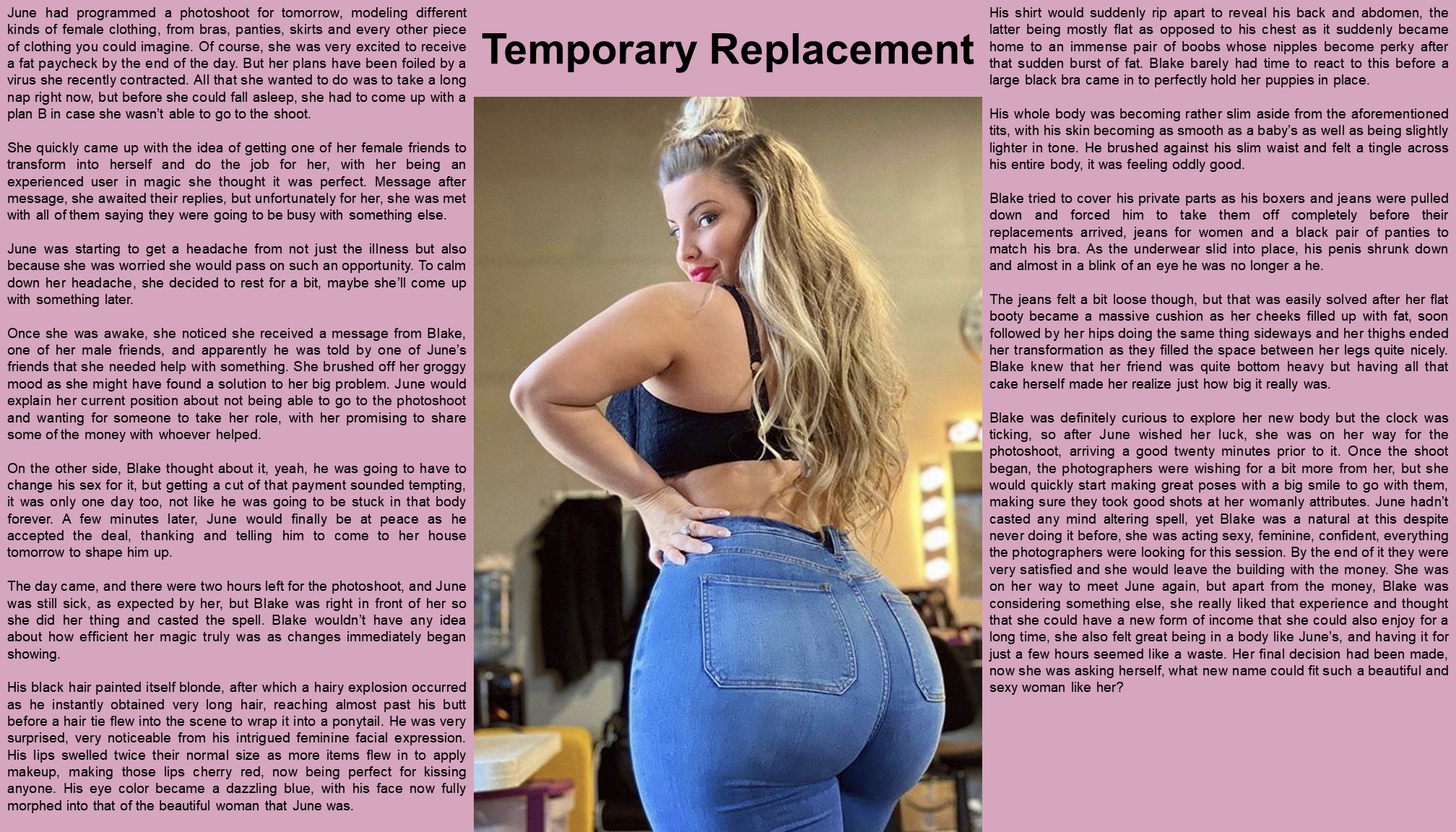Is "Temporary Replacement 2" merely a niche concept, or is it a critical adaptation shaping the future of how we manage work and relationships? The reality is that temporary replacement, in its multifaceted forms, is no longer a peripheral consideration but a central tenet of modern operational strategies, spanning both the professional and personal spheres.
The phrase "Temporary Replacement 2" resonates across various domains, from the intricate world of staffing solutions to the complexities of human interaction. It represents a dynamic approach, a strategic maneuver aimed at ensuring continuity, mitigating risk, and optimizing outcomes in the face of unforeseen circumstances or evolving needs. In the professional realm, this can manifest as a calculated move to address staffing gaps, manage workload fluctuations, or gain access to specialized expertise on a short-term basis. Consider the sudden departure of a key employee, the surge in project demands, or the need for a specific skillset not readily available within the existing team. Temporary replacement emerges as the pragmatic solution, allowing businesses to maintain operational efficiency, avoid disruptions, and maintain their competitive edge.
However, the concept extends far beyond the confines of the corporate world. Temporary replacement finds its echoes in personal relationships, where individuals may find themselves navigating challenging situations that require a temporary adjustment in roles or expectations. This could relate to a short-term absence in a personal relationship, a need for additional support during a stressful time, or the shifting dynamics within a family unit. The underlying principle remains the same: the provision of a viable, often strategic, alternative to ensure that essential functions and relationships continue to operate effectively.
The rise of the gig economy and the proliferation of remote work have further accelerated the adoption of temporary replacement models. Businesses now have access to a vast pool of skilled professionals, available on a flexible basis, and remote work capabilities enable seamless integration, regardless of geographical limitations. This shift towards a more fluid and agile workforce necessitates a proactive approach to risk management, preparing organizations to respond to unexpected challenges without significant disruption. It involves the careful selection of qualified candidates, the effective management of contracts, and the seamless integration of temporary staff into existing workflows. This is about more than simply filling a vacant position. It is about finding the right fit, at the right time, and for the right purpose, to ensure seamless integration and minimal disruption to business operations.
The essence of "Temporary Replacement 2" lies in its proactive and strategic nature. It is not merely a reaction to a problem but a carefully considered approach to workforce management, and a contingency plan designed to maintain operational continuity and optimize productivity. The implementation of successful temporary replacement strategies requires meticulous planning, clear communication, and a commitment to fostering a collaborative work environment. It is essential to define clear roles, set realistic expectations, and provide adequate training and support to ensure temporary employees can contribute effectively from day one.
The following table provides a generalized overview of the key components and considerations involved in implementing a successful temporary replacement strategy in a workplace context. The content draws inspiration from various sources, including industry reports, HR best practices, and academic research. It aims to provide a balanced and informative perspective on the topic, acknowledging both the opportunities and the challenges associated with temporary staffing.
| Component | Description | Key Considerations |
|---|---|---|
| Needs Assessment | Identifying the specific need for temporary staffing, the required skills, experience, and the duration of the engagement. |
|
| Candidate Sourcing | Identifying and attracting qualified candidates through various channels, such as recruitment agencies, online job boards, and internal databases. |
|
| Selection and Onboarding | Evaluating candidates, conducting interviews, and selecting the most suitable individual. Onboarding includes familiarizing the temporary employee with the company culture, providing necessary training, and setting clear expectations. |
|
| Performance Management | Establishing clear performance metrics, providing regular feedback, and monitoring the temporary employee's progress. |
|
| Legal and Compliance | Ensuring compliance with all applicable labor laws, including minimum wage, overtime regulations, and worker classification. |
|
| Offboarding | The process of concluding the temporary assignment, including completing final paperwork, collecting company property, and conducting an exit interview. |
|
For further, in-depth information regarding the legal aspects, best practice, and latest insights, consult reputable sources such as the Society for Human Resource Management (SHRM) or the US Department of Labor.
The world is a complex tapestry, and the need for temporary solutions will only continue to grow. Whether it's in the workplace, in sports events, or even in our most personal relationships, the ability to adapt and find viable alternatives is crucial.
Consider the context of entertainment, for example, where the concept of "temporary replacement" can take on a different, but equally relevant, meaning. We observe the rise of content creators, like those possibly involved in the "temporary replacement" saga. These content creators often rely on platforms like Patreon to offer exclusive content to their subscribers. However, as illustrated by the update in Patreon's content guidelines, the type of content allowed can change, forcing content creators to adapt. The potential for change in regulations can affect the creative process and ability to share content, impacting the availability of "non vanilla content including intruder," which serves as a creative expression.
The entertainment industry, as demonstrated by creators of content such as those in the "temporary replacement" series, often deals with sudden changes. Production schedules, the availability of actors, and even the creative direction of a project can shift, requiring quick adaptations. This aligns with the core principle of temporary replacement, in which a person or function is substituted with a temporary alternative to ensure project continuity. In this case, content creators and others involved need to be prepared to pivot their approach, whether in terms of content, platform, or creative execution. The shift can be due to external factors, such as policy changes on platforms like Patreon, or due to internal choices about the creative direction. These adjustments are all part of the dynamic of the entertainment world, which mirrors the broader application of temporary replacement across different fields.
In sports, injuries can suddenly affect team dynamics. The necessity of replacing a key player is a clear example of temporary replacement. This situation calls for immediate solutions, involving the recruitment of a replacement athlete to ensure the team's performance does not falter during key competitions.
The phrase "temporary replacement" also shows up in crossword puzzles, reflecting its common use. The search for clues related to this concept, indicates that it's a term familiar enough to be used in everyday language, indicating how widely the idea of temporary substitution is understood. The ongoing appearance of crossword clues and their solutions underscores how the concept is embedded in broader discourse. This reinforces the idea that temporary replacement is no longer just a practical solution but is a cultural touchstone.
The focus on "temporary replacement" can be tracked through social media platforms like TikTok. These platforms offer creators a means to share videos, insights, and highlights. Content creators such as those associated with the "temporary replacement" series use these platforms to generate excitement and involvement.
The concept of "temporary replacement" in the context of relationships can also mean finding ways to cope with circumstances. This can involve navigating conflicts, adjusting to changes in dynamics, or dealing with periods of separation. It is about finding a way to keep bonds. In intimate relations, this may sometimes call for discussing emotional needs. It can also be about establishing and agreeing on boundaries and expectations.
In essence, "Temporary Replacement 2" signifies more than just filling gaps; it is about strategic adaptability. It necessitates a blend of foresight, planning, and execution, crucial for maintaining continuity across various sectors. The future of this concept rests on the ability to balance adaptability with adherence to ethics. It will continue to evolve, shaped by technological advancements, changes in workforce dynamics, and the ever-shifting landscape of human connections. It's not just a temporary measure; it is a crucial skill for navigating the complexities of the modern world.


